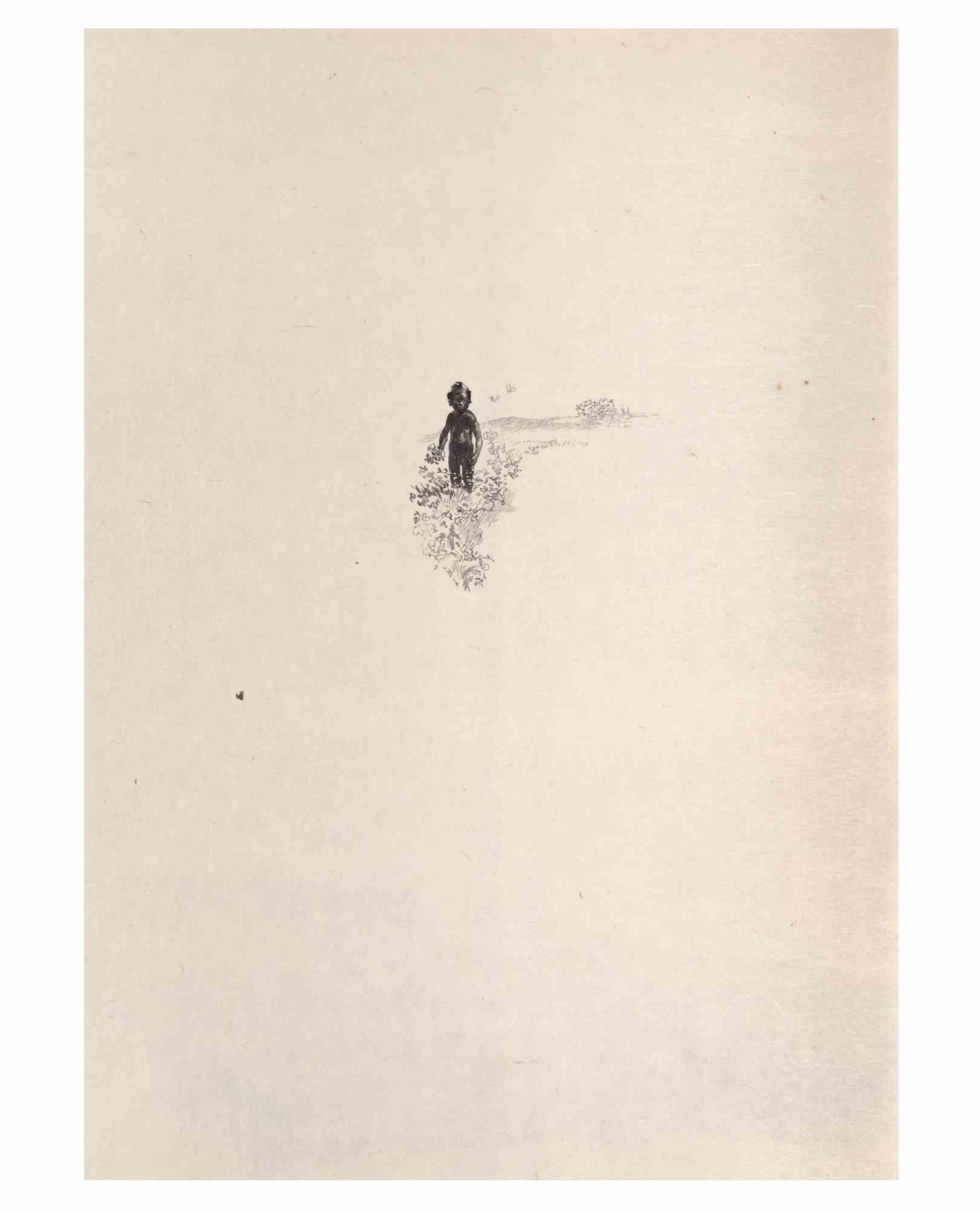Items Similar to Femininity - Lithograph
Want more images or videos?
Request additional images or videos from the seller
1 of 10
Jules PascinFemininity - Lithograph1965
1965
About the Item
(after) Jules Pascin
Title: Femininity
Signed in the plate
Dimensions: 38 x 28 cm
from the edition of 250 as issued in Warnod, Andre, "Les Peintres mes amis" (Paris: Les Heures Claires, 1965)
Jules Pascin, born Julius Mordechai Pincas, was a Bulgarian Jewish painter sometimes referred to as "the Prince of Montparnasse."
He was born on March 31, 1885 in Vidin, Bulgaria to a Spanish-Sephardic Jewish father and a Serbian-Italian mother, the eighth of eleven children. The Pincas family moved to Bucharest, Romania in 1892 and Pascin was raised there until he left for boarding school in Vienna in 1896.
While briefly working for his father’s grain merchant firm in Bucharest at fifteen, Pascin spent much of his time completing his earliest drawings in the local bordello, where he was residing under the Madame’s protection. In 1902, at the age of seventeen, Pascin moved to Vienna to study painting. The next year, he studied at the Heymann Art School in Munich. There, he supported himself by selling satirical drawings to Simplicissimus and other German magazines. Pascin would contribute drawings to a Munich daily through 1929.
Pascin’s contributions were widely recognized for their wit and insight, and upon his arrival in Paris in 1905 he was welcomed at the Gare Montparnasse by an international group of artists and writers who gathered at the Café du Dôme, which Pascin soon began to frequent regularly. The group included Grossman, Grosz, William Howard, Levy, and Emil Orlik. Pascin was also a close friend of Amadeo Modigliani.
Upon his arrival in Paris, Julius Mordechai Pincas changed his name to Jules Pascin and soon became the symbol of the Montparnasse artist community. Always in his bowler hat, he was a witty presence at Le Dôme café, Le Jockey club, and the others haunts of the area’s bohemian society, and was known for hosting legendary all-night parties. In his story, A Moveable Feast, Ernest Hemingway wrote a chapter titled With Pascin At the Dôme, recounting a night in 1923 when he had stopped off at Le Dôme and met Pascin escorted by two models. Hemingway's depiction of the events of that night is considered one of the defining images of Montparnasse at the time.
In 1907, Pascin had his first solo exhibition at Paul Cassirer Gallery in Berlin. Three years later, Cassirir commissioned Pascin to illustrate Heinrich Heine's Aus den Memoiren des Herrn von Schnabelewopski. In 1911, Pascin exhibited his work at Berlin Secession and a year later at the Sonderbund-Aussstellung in Cologne. The artist’s first exhibition in the United States was at the Armory Show in New York, where he exhibited twelve of his works.
Upon the outbreak of World War I, Pascin left Paris for London in order to avoid conscription in the Bulgarian Army. In October 1914, he immigrated to New York, where he stayed through 1920 and would later return again in 1927. Pascin was immediately welcomed into an artists circle based around the Penguin Club and became acquainted with John Quinn, an important art collector. A short time after his arrival in New York, Pascin was given a one-man show by the Berlin Photographic Company, a Madison Avenue gallery. While in New York, Pascin became associated with several progressive painters, including Walt Kuhn, Yasuo Kuniyoshi, and Max Weber. Many of these painters were influenced by Pascin’s unique style, in which he combined elements from Expressionism and Cubism with his own personal view of his environment.
Pascin used his time in the United States to travel extensively, especially in the southern states and the Caribbean islands, recording his travels in sketches that were widely acclaimed. Pascin married Hermine David in 1918. In 1920, Pascin was awarded American citizenship with support from Alfred Stieglitz and Maurice Sterne. He returned to Paris in October of that same year and met his future mistress, Lucy Krohg, the wife of the Norwegian painter Per Krohg.
While his exhibitions were generally very well received, a series of unfavorable reviews in 1930 of his exhibition at the Kniedler Galleries in New York, threw Pascin into a severe depression. After visiting his own prestigious solo exhibition at the Galerie Georges Petit on June 2nd, 1930, Pascin committed suicide by slitting his wrists and hanging himself in his studio in Montmartre. On the wall he left a message written in his own blood that said good-bye to his lost love, Elvire "Lucy" Ventura.
On the day of Pascin’s funeral, all the galleries in Paris closed. Thousands of acquaintances from the artistic community along with dozens of waiters and bartenders from the restaurants and saloons he had frequented all dressed in black and walked behind his coffin the three miles to the Cimetière de Saint-Ouen.
- Creator:Jules Pascin (1885-1930, Bulgarian, French)
- Creation Year:1965
- Dimensions:Height: 14.97 in (38 cm)Width: 11.03 in (28 cm)Depth: 0.04 in (1 mm)
- Medium:
- Movement & Style:
- Period:
- Condition:
- Gallery Location:Collonge Bellerive, Geneve, CH
- Reference Number:1stDibs: LU16122412453
About the Seller
4.9
Gold Seller
These expertly vetted sellers are highly rated and consistently exceed customer expectations.
Established in 2015
1stDibs seller since 2015
910 sales on 1stDibs
Typical response time: 2 hours
- ShippingRetrieving quote...Ships From: Collonge Bellerive, Geneve, Switzerland
- Return PolicyA return for this item may be initiated within 7 days of delivery.
More From This SellerView All
- Pablo Picasso - The Ballet Dancer - Original LithographBy Pablo PicassoLocated in Collonge Bellerive, Geneve, CHPablo Picasso - Original Lithograph Title: The Ballet Dancer Dimensions: 32 x 24 cm 1954 Reference: Bloch 767 Frontispiece for the book "Le Ballet" (Paris: Editions Hachet, 1954) by...Category
1950s Modern Portrait Prints
MaterialsLithograph
- The Human Comedy - LithographBy (after) Pablo PicassoLocated in Collonge Bellerive, Geneve, CHAfter Pablo Picasso The Human Comedy - Lithograph after an original drawing, as published in the journal "Verve" Printed signature and date Dimensi...Category
1950s Modern Figurative Prints
MaterialsLithograph
- Jean Dubuffet - original lithograph from XXe Siecle magazineBy Jean DubuffetLocated in Collonge Bellerive, Geneve, CHJean Dubuffet - Original Lithograph from XXe Siecle magazine 1958 Dimensions: 32 x 25 cm Edition: G. di San Lazzaro. Unsigned and unumbered as issuedCategory
1960s Modern Figurative Prints
MaterialsLithograph
- Marc Chagall - The Bible - Paradise - Original LithographBy Marc ChagallLocated in Collonge Bellerive, Geneve, CHMarc Chagall, Original Lithograh depicting an instant of the Bible. Technique: Original lithograph in colours (Mourlot no. 234) On the reverse: another black and white original litho...Category
1960s Modern Figurative Prints
MaterialsLithograph
- Alexander Calder - Original Lithograph - Behind the MirrorBy Alexander CalderLocated in Collonge Bellerive, Geneve, CHAlexander Calder - Original Lithograph - Behind the Mirror Original lithographs produced in 1976 Dimensions: 38 x 56 cm Source: Derrière le miroir (...Category
1970s Modern Portrait Prints
MaterialsLithograph
- Marc Chagall - The Bible - Hagar in the Desert - Original LithographBy Marc ChagallLocated in Collonge Bellerive, Geneve, CHMarc Chagall, Original Lithograh depicting an instant of the Bible. Technique: Original lithograph in colours (Mourlot no. 234) On the reverse: another black and white original litho...Category
1960s Modern Figurative Prints
MaterialsLithograph
You May Also Like
- Portrait of Giuseppe Garibaldi - Original Lithograph - Early 20th CenturyLocated in Roma, ITPortrait of Garibaldi is an original Modern Artwork realized in the early 20th Century by Anonymous artist. Lithograph on paper. The artwork is depicted through soft stokes in a w...Category
Early 20th Century Modern Figurative Prints
MaterialsLithograph
- Woman - Lithograph by Roger Chapelain-Midy - 1971Located in Roma, ITThe Rest is an original colored lithograph realized by the artist Roger Chapelain-Midy in the 1971. Hand-signed by the artist on the lower right. Numbered on the lower left. Edi...Category
1970s Modern Figurative Prints
MaterialsLithograph
- Petits Contes à ma Sœur - Lithograph by Hégésippe Moreau - 1838Located in Roma, ITPetits Contes à ma Sœur is a Lithograph on paper realized by Hégésippe Moreau in 1838. The artwork is in good condition. Hégésippe Moreau (1810-1838) was a French lyric poet. The r...Category
1830s Modern Figurative Prints
MaterialsLithograph
- Petits Contes à ma Sœur - Lithograph by Hégésippe Moreau - 1838Located in Roma, ITPetits Contes à ma Sœur is a Lithograph on paper realized by Hégésippe Moreau in 1838. The artwork is in good condition. Hégésippe Moreau (1810-1838) was a French lyric poet. The r...Category
1830s Modern Figurative Prints
MaterialsLithograph
- Petits Contes à ma Sœur - Lithograph by Hégésippe Moreau - 1838Located in Roma, ITPetits Contes à ma Sœur is a Lithograph on paper realized by Hégésippe Moreau in 1838. The artwork is in good condition. Hégésippe Moreau (1810-1838) was a French lyric poet. The r...Category
1830s Modern Figurative Prints
MaterialsLithograph
- Petits Contes à ma Sœur - Lithograph by Hégésippe Moreau - 1838Located in Roma, ITPetits Contes à ma Sœur is a Lithograph on paper realized by Hégésippe Moreau in 1838. The artwork is in good condition. Hégésippe Moreau (1810-1838) was a French lyric poet. The r...Category
1830s Modern Figurative Prints
MaterialsLithograph
Recently Viewed
View AllMore Ways To Browse
Vintage Cafe Wall Art
Vintage 1929 Hat
Vintage Bowler
The Escort
Bowler Hat
Bowler Hats
Vintage By Hemingway
Italian Hanging Wall Plates
After Party Dress
Twelve Under Plates
Alfred Maurice
Dener Dress
Vintage Funeral Sign
Vintage Bartender
Vintage Saints Hat
Vintage 1960 Party Dresses
Vintage Bohemian Wall Hanging
Hemingway Signed





